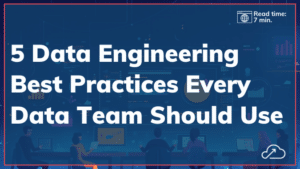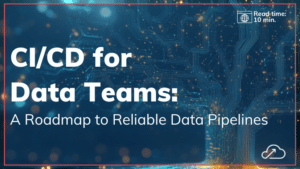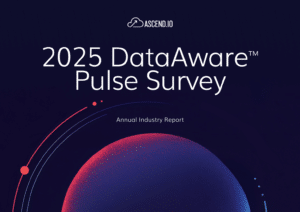Why Future-Proofing Your Data Pipelines Matters
Data has become the backbone of decision-making in businesses across the globe. The ability to harness and analyze data effectively can make or break a company’s competitive edge. But when data processes fail to match the increased demand for insights, organizations face bottlenecks and missed opportunities.
Future-proofing involves designing pipelines that can withstand the test of time, accommodating new technologies and business needs without requiring constant overhauls.
Resilience and adaptability are the cornerstones of a future-proof data pipeline. A resilient pipeline can handle unexpected changes and disruptions, while adaptability ensures that it can evolve alongside emerging technologies and business requirements. By focusing on these attributes, data engineers can build pipelines that not only meet current demands but are also prepared for future challenges.
In this blog post, we’ll explore key strategies for future-proofing your data pipelines. We’ll explore scalability, integration, security, and cost management. Each section will provide actionable insights and practical tips to help you build pipelines that are robust, efficient, and ready for whatever the future holds.
1. Scalability:
How To Build Scalable Pipelines
Scalability is a fundamental aspect of future-proofing your data pipelines. As data volumes grow, pipelines must efficiently handle increased loads without compromising performance. Designing scalable architectures ensures that your data infrastructure can expand seamlessly, accommodating new data sources and higher data throughput.
Here are three strategies to ensure your pipelines are scalable:
a. Cloud-Native Solutions
One effective strategy for achieving scalability is adopting cloud-native solutions. Cloud platforms offer flexible and scalable resources that can be adjusted based on demand. This elasticity allows data pipelines to scale up or down as needed, optimizing resource utilization and cost efficiency.
Tips for Choosing & Using Cloud-Native Solutions:
- Adopt a Cloud Service Provider (CSP): Choose a CSP like Amazon Web Services, Microsoft Azure, or Google Cloud that provides elastic, scalable resources. Ensure the provider supports the infrastructure necessary for your data needs, such as managed databases, storage, and data pipeline services.
- Utilize Cloud-Native Tools: Leverage cloud-native data pipeline tools like Ascend to build and orchestrate scalable workflows.
- Set Up Auto-Scaling: Configure auto-scaling for your data processing and storage resources. Set rules to add or reduce resources based on metrics like CPU usage, memory, or throughput, ensuring efficient resource utilization.
- Cloud Cost Monitoring and Optimization: Monitor resource use to manage costs effectively. Regularly review usage patterns and adjust cloud resource allocation as needed.
b. Distributed Data Processing Frameworks
Another key consideration is the use of distributed data processing frameworks and data planes like Databricks, Snowflake, Azure Synapse, and BigQuery. These platforms enable scalable and distributed data processing, allowing data teams to efficiently handle massive datasets.
- Databricks and Apache Spark provide robust parallel processing capabilities for big data workloads, making it easier to distribute tasks across multiple nodes and improve throughput.
- Snowflake and Azure Synapse offer powerful data warehousing solutions that simplify data integration and analysis by providing elastic scaling and optimized query performance.
- BigQuery is a fully managed data warehouse that enables super-fast SQL queries using the processing power of Google’s infrastructure, providing scalability and flexibility for large-scale data analysis.
Tools like Ascend can push workloads seamlessly to these engines and automatically optimize the workloads for better resource utilization, minimizing delays in processing data.
c. Data Partitioning Techniques
Implementing data partitioning techniques can also enhance scalability. By dividing data into smaller, manageable chunks, pipelines can process data in parallel, reducing latency and improving performance.
How to Implement Data Partitioning:
- Identify Partition Keys: Choose a partition key that allows for an even distribution of data across partitions. A good partition key should ensure that data is split evenly to avoid overloading any single partition. For example, a partition key could be a customer ID or order date—both of which can help distribute the data effectively across partitions.
- Leverage Built-In Partitioning Features: Use built-in features provided by databases like Snowflake or Databricks to automatically partition large datasets. Most modern data platforms offer automated partitioning based on specified keys.
- Monitor and Adjust: Regularly monitor partition sizes to ensure they remain balanced. Uneven partitions can lead to performance issues, so adjustments may be needed as data patterns change.
2. Integration:
Seamless Data Integration Strategies
Integrating diverse data sources is crucial for maintaining pipeline efficiency and reducing complexity. As organizations increasingly rely on a variety of data sources, seamless integration becomes a key component of future-proofing data pipelines.
Here are three opportunities to future-proof your data integration strategy:
a. Unified Data Models
One of the primary challenges in data integration is managing the diversity of data formats and structures. To address this, data engineers can implement a unified data model that standardizes data representation across different sources. This approach simplifies data processing and ensures consistency, making it easier to integrate new data sources as they emerge.
Tips for Implementing Unified Data Models:
- Define Common Standards: Establish consistent data definitions and formats across all sources to reduce discrepancies.
- Create a Central Schema: Develop a central schema that serves as a blueprint for data integration, ensuring new sources are easily aligned.
- Regular Updates: Keep the unified data model updated as new data types are added to maintain consistency.
b. Data Integration Platforms
Another strategy is to leverage data integration platforms that offer pre-built connectors and transformation capabilities. These platforms streamline the integration process by providing tools to connect, transform, and load data from various sources into a centralized repository.
Tips for Using Integration Platforms:
- Choose the Right Platform: Use platforms that provide a wide range of connectors and offer the ability to build your own custom connectors. This flexibility is crucial to future-proofing your pipelines.
- Choose Platforms with Broad Solutions: Consider platforms and tools that provide a wide range of solutions. End-to-end data pipeline platforms like Ascend not only natively integrate with various data sources but also enable seamless data transformation and delivery. These comprehensive solutions limit technical debt and reduce the complexity of integrating multiple tools into your data platform.
- Automate Data Transformation and Orchestration: Automate data cleaning and transformation tasks using a data automation tool like Ascend to reduce manual effort and improve data consistency.
c. API-Driven Integration
Incorporating API-driven integration is also essential for future-proofing data pipelines. APIs facilitate communication between different systems, allowing data to flow seamlessly across platforms.
By adopting an API approach, organizations can ensure that their data pipelines remain flexible and adaptable to changing business needs. With tools like Ascend, you can implement API connections using Python, keeping your pipelines flexible.
Tips for API-Driven Integration:
- Adopt an API-First Strategy: Design your integration with APIs in mind from the start, ensuring flexibility and scalability.
- Use REST or GraphQL APIs: Choose appropriate API standards like REST for standard integrations or GraphQL for more complex queries.
- Monitor API Performance: Regularly monitor the performance of APIs to ensure they are functioning efficiently and not causing bottlenecks.
3. Security:
Ensuring Data Pipeline Security
Robust security measures are vital for protecting data integrity and ensuring compliance with regulations. As data pipelines become more complex and handle increasingly sensitive information, implementing strong security practices is essential for future-proofing.
Here are 5 methods for securing your data pipelines.
a. Data Encryption
One of the most effective ways to secure data pipelines is through encryption. Encrypting data both at rest and in transit ensures that sensitive information remains protected from unauthorized access. This is particularly important for organizations handling personal or financial data, where breaches can have severe consequences.
b. Access Controls
Access controls are another critical component of data pipeline security. Ensure your data platforms have implemented Role-Based Access Control (RBAC) to ensure that only authorized personnel have access to specific data and pipeline components. This minimizes the risk of data breaches and helps maintain compliance with data protection regulations.
c. Security Audits and Vulnerability Assessments
Regular security audits and vulnerability assessments are essential for identifying potential weaknesses in data pipelines. By proactively addressing security gaps, organizations can prevent breaches before they occur. Conduct audits at regular intervals, at least once a quarter.
d. Data Masking and Anonymization
Data masking and anonymization techniques enhance security by obscuring sensitive information. These techniques allow data to be used for analysis and testing without exposing sensitive details, reducing the risk of data leaks.
e. Monitoring and Alerting Systems
Implementing comprehensive monitoring and alerting systems is crucial for maintaining data pipeline security. Real-time monitoring allows organizations to detect and respond to security threats promptly, minimizing potential damage. Configure alerts for suspicious activities such as unauthorized access attempts or unusual data flows.
4. Cost Management:
Optimizing Costs in Data Pipelines
Effective cost management is critical to ensuring that data pipelines remain sustainable and efficient. As data volumes increase and pipelines become more complex, managing operational costs without compromising performance becomes vital for future-proofing.
Here are 3 methods for optimizing your pipelines at scale.
a. Resource-Efficient Processing Techniques
One strategy for optimizing costs is to implement resource-efficient data processing techniques. By using data partitioning and compression methods, organizations can reduce storage and processing costs. These techniques minimize the amount of data that needs to be processed at any given time, leading to significant cost savings.
Tips for Implementing Resource-Efficient Processing:
- Data Compression: Use compression techniques to reduce data storage requirements and improve processing efficiency.
- Partitioning Strategies: Leverage partitioning strategies to manage data efficiently, ensuring that only necessary data is processed.
b. Cloud-Based Solutions
Cloud-based solutions offer another avenue for cost optimization. By leveraging cloud platforms, organizations can take advantage of pay-as-you-go pricing models, which allow them to scale resources based on demand. This flexibility ensures that organizations only pay for the resources they use, reducing unnecessary expenses.
Tips for Leveraging Cloud Solutions:
- Select Pay-As-You-Go Services: Choose cloud services that allow for cost-effective, scalable resource allocation.
- Regular Cost Reviews: Perform regular cost reviews to identify potential savings opportunities and avoid wasteful resource spending.
c. Automation of Routine Tasks
Automating routine tasks and processes helps reduce manual effort, minimize errors, and improve overall efficiency, ultimately driving down operational costs.
Tips for Automating Tasks:
- Identify Repetitive Tasks: Identify processes that are repetitive and prone to human error, such as data validation, and automate them.
- Use Workflow Orchestration Tools: Implement pipeline orchestration tools to automate the entire data pipeline, reducing manual touch points and increasing consistency. With Ascend’s DataAware Automation, pipelines only reprocess data as needed cutting back on unnecessary costs that can add up, especially as data scales.
- Monitor and Optimize Automation: Regularly monitor automated processes to identify bottlenecks or areas for further improvement.
Conclusion:
Achieving Resilience in Data Pipelines
Future-proofing data pipelines requires scalability, integration, security, and cost management. Scalability ensures that pipelines can handle growing data volumes without compromising performance, while integration of diverse data sources reduces complexity and boosts efficiency. Robust security measures protect data integrity and maintain compliance. Effective cost management keeps pipelines sustainable and efficient. By implementing these strategies, data engineers can create pipelines that are resilient, adaptable, and ready for the future.





